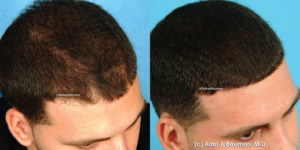By Alan J. Bauman, MD, ABHRS

it is more likely that you’ll join the more than 80 million men and women in the U.S. suffering from hair loss.
5 Scary Hair Loss Truths
1. The use of Minoxidil is FDA-approved for hair regrowth and has proven science behind it but the reality is it doesn’t work for everyone. In fact, over-the-counter minoxidil may only work well in about 35 percent of patients, according to medical studies, meaning there is a 65 percent chance standard over-the-counter minoxidil, like Rogaine, may not help you. Some patients require a specially formulated, compounded prescription minoxidil solution (like Formula 82M) for optimal results.
2. By the time hair loss becomes noticeable to the naked eye, about 50 percent of the hair follicles may have already been lost. The earlier patients can get started on preventive or restorative therapies, the better their odds are for retaining a full and healthy hairline and head of hair.
3. According to the American Hair Loss Association, by the age of 35, approximately one-third of men will experience some degree of hair loss; and by the age of 50, 50% of men will have significantly thinning hair. As a man ages, the risk of losing hair increases, and is proportional to age: 60% in 60s, 70% in 70s, and so on.
4. Roughly half of all women over the age of 40 suffer from some form of hair loss. That’s right – half. While most people tend to think of hair loss as a man’s problem, the reality is that women are almost just as likely as men to lose hair. It’s just less noticeable from afar because it happens more diffusely.
5. Medications, laser therapy, PRP, nutritionals, etc. can help make hair follicles grow thicker healthier hair, but once the follicle is dead and gone, the only option for restoring hair in that area is a hair transplant.
Is “Vampire PRP” the Answer to Your Hair Loss?
While it may sound like something out of a horror story, one of the most promising tools to treating hair is — your blood. While this may conjure up unsettling images of vampires, the treatment is actually simple, quick and highly effective.
How exactly does “vampire” therapy breathe new life into failing follicles, and is it right for you? Platelet-rich plasma (PRP) therapy, also commonly referred to as “Vampire PRP,” is one of the most promising cell therapy treatments to become available for hair loss sufferers in recent years.
Following a simple blood-draw, the patient’s blood is spun in a special centrifuge with specific kits designed to separate and concentrate blood platelets, producing the high-quality PRP – a powerful growth factor “cocktail.” Once activated, platelets release powerful molecules, which have profound biologic regenerative effects on the hair follicles and skin. Under comfortable local anesthesia, this powerful cocktail of growth factors, cytokines and other proteins is injected into the area of the scalp where weak hair follicles exist. PRP may be enhanced through the use of placental extracellular matrix (ECM) called BioD or another ECM from dried porcine bladder called ACell.
PRP has become one of the most exciting recent breakthroughs in hair restoration, and is not only showing positive results as a stand-alone treatment, it has proven to be a valuable tool during hair transplantation on as well. During the transplant process, PRP has been shown to strengthen non- transplanted hair, minimize donor scarring and accelerate wound healing. In addition, PRP has been reported by some hair transplant surgeons to improve graft survival.
In addition to its effectiveness in treating certain types of hair loss, a growing number of patients are drawn to PRP because of its quick and non-invasive nature. Performed correctly, this virtually painless outpatient procedure takes about one hour and requires no downtime for patients, which means you could literally have it performed during lunchtime. Mild soreness or swelling, if any, resolves in less than a day and when administered correctly and improved hair growth may be measured in a matter of weeks.
Early Intervention
The biggest takeaway should be that early intervention is the key to preventing and managing hair loss. Once you understand the cause of your hair loss, you need to determine the best way to stop losing more hair, enhance the hair you have and restore the hair you’ve lost. For most patients, this means using a combination, or ‘multi-therapy’ approach: non-invasive treatments to protect the hair you have and hair transplantation to restore the hair you’ve lost. Some patients might accomplish their goals using only non-invasive treatments.
For more information PRP, or other effective treatments for hair loss, please visit www.baumanmedical.com or call 561-220-3480
Check Also
Trusted Homecare Agency: Serving Veterans with Free Supplemental Home Healthcare
When it comes to healthcare, veterans deserve the best care possible. For veterans seeking in-home …
 South Florida Health and Wellness Magazine Health and Wellness Articles
South Florida Health and Wellness Magazine Health and Wellness Articles




